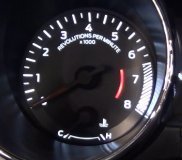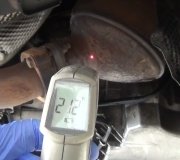Start by checking for diagnostic fault codes. If there are any stored in the Engine Computer's memory that could result in increased tail pipe emissions, the computer will turn on the Check Engine light. There can be other codes that don't cause the light to be on but could affect engine performance. Many auto parts stores can read codes for you but their equipment does not access sensor data or perform actuator tests. There is also a procedure you can do to read the codes. Chrysler has, by far, the easiest way for the owner to access this information.
Turn the ignition switch from "off" to "run", to "off" to "run", "off" to "run", three times without cranking the engine. If the starter engages even for an instant, turn the switch off and wait a few seconds before starting over. This must be done within 5 seconds. After the third time, leave the switch in the "run" position. In a few seconds the Check Engine light will begin to flash a series of two-digit codes. Count the flashes, there will be a short pause, then another series of flashes will be the second digit. After a longer pause, the second code, if there is one, will flash the same way. Record all of the codes. If you miscount, some older systems will continue to repeat the sequence until the ignition switch is turned off or the engine is started. If you need to restart the sequence manually, just turn the switch off and back on once.
Most vehicles will start with code 12. That just means the ignition switch was turned off. You can disregard that one if it shows up. The last code will be code 55. Disregard that too. It just means "end of message".
Every sensor has an acceptable range for its signal voltage. The MAP and throttle position sensor, for example, are fed 5.0 volts, but their signal voltages must remain between.5 and 4.5 volts. Anything outside those values will disappoint the Engine Computer. It will set the appropriate code, and if the problem is constant, will ignore the sensor and make educated guesses based on the readings from other sensors. Engine performance will suffer but at least it will still run.
As long as a sensor's value is within the acceptable limits, the computer will believe it even though the value might be wrong. This is often the way a MAP sensor starts to fail. His job is to measure engine load based on intake manifold vacuum. Chrysler is the only manufacturer that can make an engine run properly without the miserable Mass Air Flow sensor. Their MAP sensor is the same part used on many GM vehicles as a backup system to their MAF sensors.
'When the ignition switch is turned to "run", but before the engine starts, the MAP sensor's reading represents barometric air pressure. If that value is incorrect, or if the vacuum readings are incorrect when the engine is running, incorrect amounts of fuel will be commanded from the injectors. Usually MAP sensors don't take very long to fail completely. You might also look for a cracked / leaking / disconnected hose going to the MAP sensor.
When a sensor hasn't failed completely, it can sometimes be detected by the computer if it doesn't agree with other sensors. For example, the MAP sensor could report a high load on the engine such as when accelerating, and the throttle position sensor could report the gas pedal is released and the engine is at idle, but they can't both occur at the same time. The computer will know by vehicle speed and engine speed which sensor is wrong even though the value its reporting is within acceptable limits.
If no fault codes are in the computer's memory, your mechanic can connect a hand-held computer, called a scanner, to observe live sensor data and possibly pick out which one is not correct. Most aftermarket scanners, and all of Chrysler's equipment, have the capability to record a few seconds of sensor data to be scrutinized later. The "record" button is pressed when the problem occurs. Since the data is still in the scanner's memory, the recording actually starts a few seconds before the button is pressed.
Other things that could cause bogging or hesitation include low fuel pressure, (not common on Chrysler products), spark plug wires, (very common with original wires on 3.3L), an oxygen sensor or a coolant temperature sensor if the problem only occurs after the engine is warmed up, or a dropout in the throttle position sensor, (should be detected by the computer).
If low fuel pressure is suspected as a last resort, disconnect the vacuum hose from the pressure regulator and plug it. That will cause pressure to go to its highest. There will likely be black smoke from the exhaust, but the hesitation will be gone. Don't drive it very long like that because the excess fuel will overheat and melt the catalytic converter.
Connect a mechanical fuel pressure gauge and compare its reading to specs. It should be at least 45 psi. With the vacuum hose connected, fuel pressure will drop when intake manifold vacuum is high such as when coasting. Fuel pressure will go up when accelerating. If pressure is too low, suspect a plugged pickup screen attached to the pump in the tank, although this usually causes a stall during coasting.
Caradiodoc
Saturday, March 13th, 2010 AT 2:18 PM



